WHO'S IN A NAME?
People Commemorated in Eastern Sierra Plant Names
Return to Index
White tidy-tips (white layia), Layia glandulosa (Hook.) Hook. & Arn. (Asteraceae)
by Larry Blakely
References and Notes
(First Posted: 2000 10 31; Last Revised: 2000 10 31; Text appeared in the newsletter of the Bristlecone chapter, CNPS, November, 2000/Vol. 20, No.6)
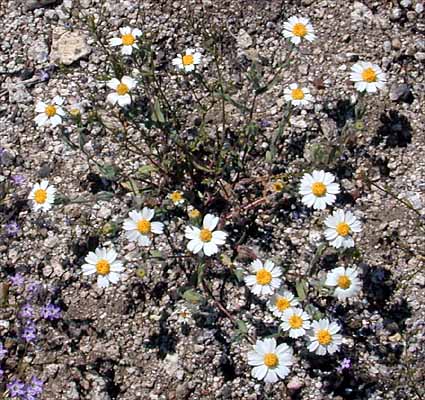
White tidy-tips, Layia glandulosa (Hook.) Hook. & Arn. (Asteraceae)
Check the CalFlora website for more information and pictures.
Photos © by Larry Blakely

The 1820s and 1830s saw several plant explorers come to California seeking plants as yet unknown to science; among the more famous were Johann Eschscholtz, David Douglas, and Thomas Nuttall. Very few collectors had come before, so it was nearly virgin territory.
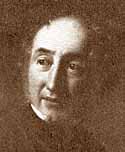
Sir William Jackson Hooker (1)
Most collections were "worked up" by botanists back home, such as Sir William Hooker, Professor of Botany at the University of Glasgow and, later (1842), Director of Kew Gardens near London. The Eastern Sierra hosts many plants bearing the names of those early 19th century collectors and/or back-home botanists. For example, there are nearly 150 associated with Hooker.(2)
One lesser-known collector of the 1820s was George Tradescant Lay, naturalist on the English sailing ship Blossom, under the command of Captain Frederick Beechey.(3), (4), (5) The Blossom left England in 1825, returning in 1828, on a voyage of exploration, and also to support another English party which was searching for the fabled Northwest Passage. For over two years the crew criss-crossed the now violently stormy, now aggravatingly placid, Pacific Ocean, at times tracing the paths of the ships of exploration commanded by Captains Vancouver and Cook some 35 to 60 years previously (those ships also carried famous botanical explorers). (6), (7) The Blossom also followed part of the path of the Bounty, whose crew so infamously mutinied in 1789 against that strict disciplinarian, Captain Bligh.(8)
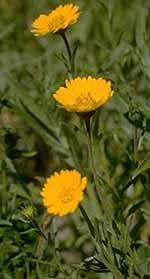
Layia gaillardioides (Hook. & Arn.) DC. - Beatrice F. Howitt photo, © California Academy of Sciences
Lay, and others on the Blossom, collected extensively on South Pacific islands, Hawaii, Kamchatka, Alaska, California (gathering 175 plant species there (9)), China, Mexico, and South America. A famous flora by Hooker, "The Botany of Captain Beechey's Voyage", appeared in the years after the Blossom's return.(5)
Hooker proposed the genus name Layia in honor of Lay, whom he credited as one of the discoverers of a plant now called Layia gaillardioides. (In a rare lapse, he also gave the genus name Layia to a legume Lay collected in China, an error later corrected.(9a)) The Eastern Sierra Layia, L. glandulosa, was first collected by the great Scottish plant explorer David Douglas while on the "plains of the Columbia" (10), at about the time the Blossom was visiting California; it was named by Hooker in the "California Supplement" to his work on the Beechey materials. Currently, there are 14 species of Layia, according to the USDA Plants Database.(11)
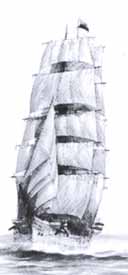
All early 19th century plant collectors who visited California, like most long distance travellers of the time, experienced the dangers and privations of the sea, something most of us can only appreciate vicariously, through books or movies. Richard Henry Dana's "Two Years Before the Mast" brilliantly describes a long voyage, from Boston around 'the Horn' to California and back in the mid 1830s; he also tells of the amazing chance encounter with his old Harvard professor, Thomas Nuttall, at San Diego.(12) The 1935 movie "Mutiny on the Bounty", based on the historical novel (8), graphically portrays life at sea in those times.
It was fortunate for Lay and others on the Blossom that, although they faced the perils meted out by Nature to all seamen in the frail ships of the time, the gentlemanly Capt. Beechey was no grumpy Capt. Bligh! His delightful journal of the voyage of the Blossom is a joy to read.(4) He discusses the "natural productions" (plants, mainly) found at each of their many stops, and the different kinds of people encountered - South Sea Islanders, Bounty mutiny descendants (and a sole survivor) on Pitcairn Island (13), Eskimos, and mission Padres in California, among others.
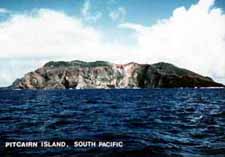
Pitcairn Island
Little is known of the life of Lay (born ?, died 1841). His middle name is the surname of the John Tradescants, father and son (1570-1638, 1608-1662), famous plantsmen of their age - royal gardeners, horticulturists and plant explorers.(14) Based on Lay's middle name, it's plausible to suppose that his family was involved in some way with botany, but nothing appears to be known now of his life before he joined the crew of the Blossom. A few years after the return of the Blossom, Lay was back in China, not as a naturalist but as a missionary, sent out by the British and Foreign Bible Society. Shortly before his death he published a book entitled "The Chinese as They Are: Their Moral, Social and Literary Character." (15)
Next time you run across white tidy-tips in bloom, with their dainty flower heads that often appear to have a tooth missing, maybe you'll be reminded of those bygone days of exploratory sailing vessels, when botanical discovery was a predominant scientific passion. And anytime would be a good time to view the 1935 version of "Mutiny on the Bounty" with Charles Laughton as Bligh and Clark Gable as mutiny instigator Christian; Henry Stephenson appears as the famous 18th century English botanist Sir Joseph Banks (6), who was largely responsible for sending the Bounty to Tahiti. It's not often that you see a famous botanist portrayed in a major movie (he also figured prominently in the historical novel on which the movie was based, but he was not included in the two later cinematic versions of the Bounty saga).
REFERENCES and NOTES
- Copied from an illustration in Davies, J. 1980. Douglas of the Forests. Harris, Edinburgh; attributed to the Linnean Society.
- According to a search of the CalFlora database.
- McKelvey, Susan Delano. 1956. Botanical Exploration of the Trans-Mississippi West 1790-1850. 1991 Reprint, Oregon State Univ. Press, Corvallis. pp. 1031-1038.
- Beechey, Frederick W. 1831 (1968, reprint). Narrative of a Voyage to the Pacific and Beering's Strait to co-operate with the Polar Expeditions: performed in His Majesty's Ship Blossom. London (reprint - N. Israel, Amsterdam)
- Hooker, W. J., and Arnott, B. A. Walker. 1830-1841; reprint 1965. The Botany of Captain Beechey's Voyage. Reprint: J. Cramer, Weinheim.
-
Cook's botanist in 1768 was Joseph Banks (already, at 26 years of age, Fellow of the Royal Society, and later Sir Joseph), who, through an inheritance at age 21, was one of the wealthiest men in England. Banks devoted his life to science, most particulary botany. Kew Gardens grew to become a world center of botany under his influence, along with that of his friend King George III. Banks' journal of the voyage with Cook on the Endeavour, 1768-1771, is wonderfully presented at a website from the State Library of New South Wales. A brief biography from the same site is here: http://www.slnsw.gov.au/Banks/intro/biognote.htm. For more on Banks, see: Watkins, T. H. 1996. Sir Joseph Banks. National Geographic. 190(5):28-53

Joseph Banks, 1773
- Vancouver's botanist, Archibald Menzies, collected in California in the 1790s.
- Nordhoff, Charles, and Hall, James Norman. 1932. Mutiny on the Bounty. Little, Brown 7 co., Boston. An historical novel.
- Brewer, William. H. 1880. List of Persons who have made Botanical Collections in California. Appendix IV to Watson, Sereno. 1880. Botany of California, Vol. II. (Geol. Surv. of Calif.) Little, Brown and Co., Boston.
9a. See: Hooker and Arnott (5), p. 183; Coville, F. V. 1893. Botany of the Death Valley Expedition. GPO., p. 133.; and Index Nominum Genericorum. - Cronquist, Arthur, et al. 1994. Intermountain Flora. Vol. 5. New York Botanical Garden. p. 686
- http://plants.usda.gov/
- Dana, Richard Henry, Jr. 1840. Two Years Before the Mast; A Personal Narrative of Life at Sea. Various publishers. On-line e-text at: ftp://ftp.cdrom.com/pub/gutenberg/etext00/2yb4m10.txt.
Of particular interest for the history of western US botany, Dana, in an extraordinary coincidence, happened upon Thomas Nuttall at San Diego in 1836. Dana's ship was preparing to return to Boston, and Nuttall was to be a passenger on it. Dana first saw Nuttall on the beach, collecting shells. What was amazing was that Dana had known Nuttall at Harvard, as a professor just a couple of years previously and had no idea that Nuttall had left the place. Dana wrote:
This passenger--the first and only one we had had, except to go from port to port, on the coast, was no one else than a gentleman whom I had known in my better days; and the last person I should have expected to have seen on the coast of California--Professor N-----, of Cambridge. I had left him quietly seated in the chair of Botany and Ornithology, in Harvard University; and the next I saw of him, was strolling about San Diego beach, in a sailor's pea-jacket, with a wide straw hat, and barefooted, with his trowsers roiled up to his knees, picking up stones and shells. He had travelled overland to the North-west Coast, and come down in a small vessel to Monterey. There he learned that there was a ship at the leeward, about to sail for Boston; and, taking passage in the Pilgrim, which was then at Monterey, he came slowly down, visiting the intermediate ports, and examining the trees, plants, earths, birds, etc., and joined us at San Diego shortly before we sailed. The second mate of the Pilgrim told me that they had an old gentleman on board who knew me, and came from the college that I had been in.
He could not recollect his name, but said he was a "sort of an oldish man," with white hair, and spent all his time in the bush, and along the beach, picking up flowers and shells, and such truck, and had a dozen boxes and barrels, full of them. I thought over everybody who would be likely to be there, but could fix upon no one; when, the next day, just as we were about to shove off from the beach, he came down to the boat, in the rig I have described, with his shoes in his hand, and his pockets full of specimens. I knew him at once, though I should not have been more surprised to have seen the Old South steeple shoot up from the hide-house. He probably had no less difficulty in recognizing me. As we left home about the same time, we had nothing to tell one another; and, owing to our different situations on board, I saw but little of him on the passage home. Sometimes, when I was at the wheel of a calm night, and the steering required no attention, and the officer of the watch was forward, he would come aft and hold a short yarn with me; but this was against the rules of the ship, as is, in fact, all intercourse between passengers and the crew. I was often amused to see the sailors puzzled to know what to make of him, and to hear their conjectures about him and his business. They were as much puzzled as our old sailmaker was with the captain's instruments in the cabin.
He said there were three:--the chro-nometer, the chre-nometer, and the the-nometer. (Chronometer, barometer, and thermometer.) The Pilgrim's crew christened Mr. N. "Old Curious," from his zeal for curiosities, and some of them said that he was crazy, and that his friends let him go about and amuse himself in this way. Why else a rich man (sailors call every man rich who does not work with his hands, and wears a long coat and cravat) should leave a Christian country, and come to such a place as California, to pick up shells and stones, they could not understand. One of them, however, an old salt, who had seen something more of the world ashore, set all to rights, as he thought,--"Oh, 'vast there!--You don't know anything about them craft. I've seen them colleges, and know the ropes. They keep all such things for cur'osities, and study 'em, and have men a' purpose to go and get 'em. This old chap knows what he's about. He a'n't the child you take him for. He'll carry all these things to the college, and if they are better than any that they have had before, he'll be head of the college. Then, by-and-by, somebody else will go after some more, and if they beat him, he'll have to go again, or else give up his berth. That's the way they do it. This old covey knows the ropes. He has worked a traverse over 'em, and come 'way out here, where nobody's ever been afore, and where they'll never think of coming." This explanation satisfied Jack; and as it raised Mr. N.'s credit for capacity, and was near enough to the truth for common purposes, I did not disturb it. - History and current conditions on Pitcairn Island may be found here: http://www.lareau.org/pitc.html
-
A website with information on the Tradescants: The Museum of Garden History.

John Tradescant, the elder
- CHURCH MISSIONARY SOCIETY ARCHIVE Section I: East Asia Missions Part 10: China Mission, 1834-1914 30 reels of 35mm silver-halide positive microfilm REEL 222 C CH O 57 Original Papers Letters and Papers of Missionaries George Tradescant Lay 1837-1838; On-line: http://www.adam-matthew-publications.co.uk/COLLECT/P055.HTM
A Chronology of the Bonin Islands Sebastian DOBSON (Old Japan, London) 1837. London. George Tradescant Lay, who had originally accompanied Beechey on HMS Blossom as a naturalist, and has since worked in China as an agent of the British and Foreign Bible Society, publishes an open letter to 'the British Public' dated 27 November 1836 in which he urges that the occupation of the Bonin Islands 'would give the English nation such a respectability in the eyes of all around', and fulsomely concludes that 'this spot might, under the blessing of the Almighty, be the focus from whence the influences of religion, science, and the sentiments of political freedom, would emanate in an ever-flowing tide.'[15] [15] G. Tradescant Lay: Trade with China. A Letter Addressed to the British Public on some of the Advantages that would Result from an Occupation of the Bonin Islands. London: Royston & Brown, 1837. On-line: http://nihongo.human.metro-u.ac.jp/bonins/03dobson.htm
Selections on Microfilm from the Yale Day Missions Collection Subject Headings CHINA--SOCIAL LIFE AND CUSTOMS. Lay, G. Tradescant (George Tradescant) The Chinese as they are : their moral and social character, manners, customs, language : with remarks on their arts and sciences, medical skill, the extent of missionary enterprise, etc. Albany : George Jones ; New York : Burgess and Stringer, 1843. iv, 116 p. 0101 On-line: http://www.atla.com/products/preservation/yaleday.html